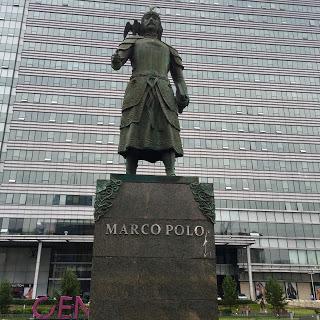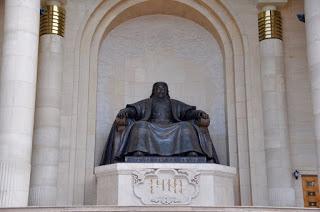 If you're a regular reader of this blog, you probably noticed a distinct lack of posts over the course of a couple of weeks earlier in the month. That's because I left the friendly and comfortable confines of my home to fly halfway round the world to take part in a fantastic adventure in the wilds of Mongolia. A few months back, I received an invite from my good friends at Tusker Trail – an adventure travel company without peer – to join them on a once-a-year outing into the Altai Mountains of Mongolia. The trip is a combination of trekking and horseback riding in a part of the world that is seldom visited by outsiders they said, which was about all I needed to hear to convince me to join in on the fun.
If you're a regular reader of this blog, you probably noticed a distinct lack of posts over the course of a couple of weeks earlier in the month. That's because I left the friendly and comfortable confines of my home to fly halfway round the world to take part in a fantastic adventure in the wilds of Mongolia. A few months back, I received an invite from my good friends at Tusker Trail – an adventure travel company without peer – to join them on a once-a-year outing into the Altai Mountains of Mongolia. The trip is a combination of trekking and horseback riding in a part of the world that is seldom visited by outsiders they said, which was about all I needed to hear to convince me to join in on the fun.Located in Central Asia, Mongolia is a completely landlocked nation that shares borders with both Russia and China. It is home to approximately 3.1 million people, of which about a third live in the capital city of Ulaanbaatar. Outside that city there are a number of other smaller urban settings, but for the most part the country is punctuated with wide-open landscapes, snow-capped peaks, and the sweeping vistas of the Gobi Desert. In short, it is an adventure traveler's dream destination, with plenty to see and do. The fact that the country also has a rich culture, and a deep history only adds to the allure.
They say that when setting out on any great adventure, the journey is half the fun. In this case, that means flying to Ulaanbaatar – often referred to simply as UB. Getting to UB isn't particularly difficult, although it does require flying through either Beijing, China or Seoul, South Korea. In my case that meant hopping a short 1.5 hour flight to Chicago's O'Hare Airport, where I would then load onto a larger plane that would travel 12.5 hours to Beijing. None of that is particularly challenging for an experienced traveler who has done this many times before, but the 8+ hour layover in China on the other end was on the grueling side. Particularly so since I arrived in the afternoon, and had to wait until nearly 2 AM to catch my next flight, which would ultimately take me to Ulaanbaatar. I whiled away the time as best I could, and eventually I found myself on yet another aircraft, this time bound for my final destination.
The flight to UB from Beijing was approximately three hours in length, which meant I arrived in Mongolia early in the morning and desperate for some sleep. Still, I was intrigued with the setting and eager to see more of the place which I had heard so much about but had never experienced for myself. What I discovered was a surprisingly modern city that was neat, clean, and orderly. Sure, there was plenty of traffic, and the sidewalks were filled with pedestrians hustling too and fro, but Ulaanbaatar had a nice sense of calm about it that came in striking contrast to a place like Kathmandu for instance, where chaos, noise, and the constant threat of rolling blackouts are the norm. The Toyota Prius also seems to be the vehicle of choice for those living in UB as well, as there were an inordinate number of the cars choking the streets of the capital.
Over the course of the next couple of days, I'd get a chance to explore UB a lot further, taking in its unique architecture (Soviet style buildings blend with thoroughly modern structures), meeting some of its people, and visiting a number of cultural centers, including the National Museum and Ganging monastery, a Buddhist temple that should not be missed. I also had the opportunity to attend a performance of local dancers and musicians that featured traditional instruments, demonstrations of the legendary Mongol throat singing, and a colorful display of costumes. The highlight of the show for me was its closing act, which included the 60+ piece Mongolian State Orchestra playing classical music from the country's long historical past.
 Speaking of history, it is impossible to ignore the influence that Mongol legend Genghis Kahn still has on the country. The image of the man who established the once massive and powerful Mongol Empire more than eight centuries ago can be seen just about everywhere. Not only is he on the local currency, there are statues of him at the main government building, and banners commemorating his deeds handing in the Ulaandbaatar international airport, which also happens to bear his name. There is even a massive sculpture of the Great Kahn on horseback that stands 40 meters (131 ft) in height that is found nearby.
Speaking of history, it is impossible to ignore the influence that Mongol legend Genghis Kahn still has on the country. The image of the man who established the once massive and powerful Mongol Empire more than eight centuries ago can be seen just about everywhere. Not only is he on the local currency, there are statues of him at the main government building, and banners commemorating his deeds handing in the Ulaandbaatar international airport, which also happens to bear his name. There is even a massive sculpture of the Great Kahn on horseback that stands 40 meters (131 ft) in height that is found nearby.For Mongolia, Genghis is the equivalent of George Washington, which is to say the man who founded what would become a modern nation. In the 13th century he created the building blocks for the largest geographical empire in human history, which is why he still revered there today. Some of his sons and grandsons (most notably Ogedei and Kublai) are also seen in statues and on banners throughout the capital as well. These signs of a bygone era aren't simply examples of Mongolians clinging to their once-great past however, but are instead a sign of pride in their heritage, which has helped to shape who they are as a people today.
Genghis isn't the only major influence on the country's history however, as both China and the Soviet Union played major roles in its development during the 19th and 20th century. Those influences can still be felt throughout Mongolia as well, particularly in the way that the cities have been built, and the style of architecture that is common there. In 1990, the country threw off the yoke of Soviet control however, and has been an independent, democratic nation ever since.
My first few days in Mongolia were spent in UB getting my feet back under me and shaking off jet lag from the long trip. That chance to catch my breath was a welcome one, as I knew that the journey ahead would be physically demanding, but incredibly rewarding at the same time. By our third day in country my group was preparing to leave the modern setting of Ulaanbaatar behind and set out for decidedly more rural and remote locales. What we would find would exceed all of our expectations, and deliver a once in a lifetime adventure that was befitting any Mongol nomad of the past.
Stay tuned for more. I'll be following up this story with second part of the tale soon. I hope you've enjoyed the start. More to come!

